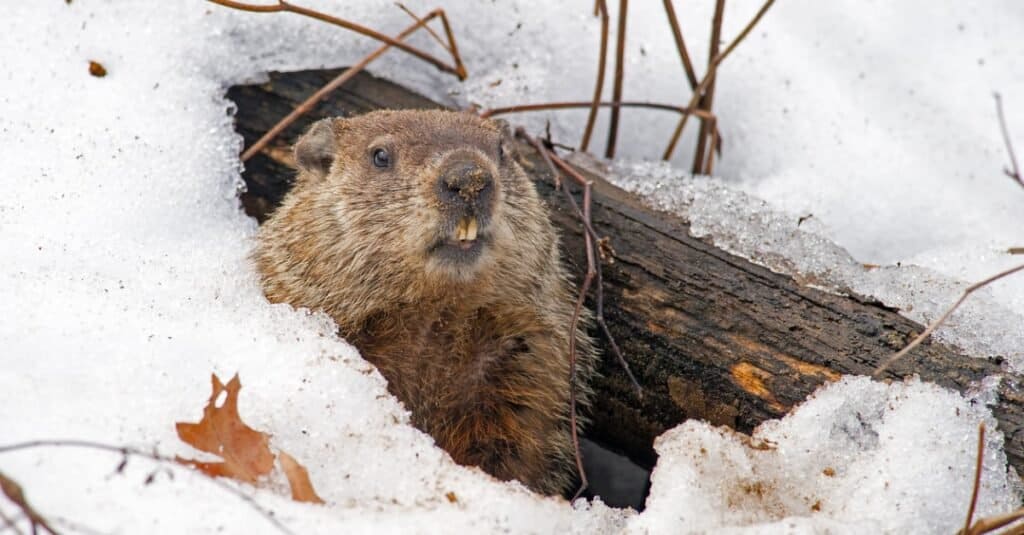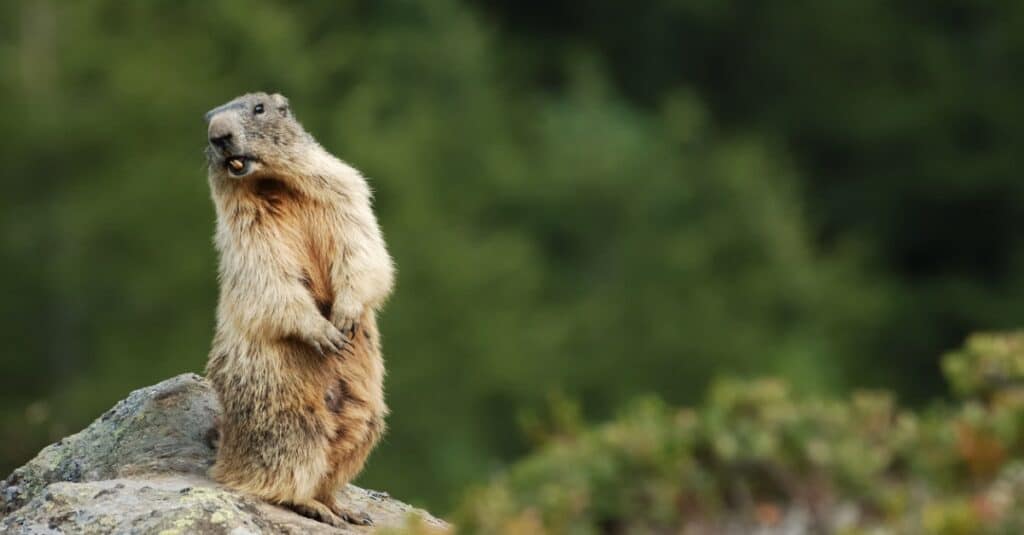Because of their strong claws, groundhogs (also known as woodchucks) can readily climb trees, cliffs, and other surfaces. That being said, they only ascend when absolutely essential. It should come as no surprise that a groundhog loves to stay on the ground, given its namesake.
Typically, woodchucks only climb trees to get away from big predators. These mammals may easily elude large predators by using their robust claws to climb and dig away from them. Just as well, woodchucks can climb up trees to harvest fruits and leafy greens.
Woodchucks are capable of scaling both natural and man-made structures. Despite having powerful nails, woodchucks can only puncture certain materials. Woodchucks have also been known to nibble on certain objects to ease the pain of their developing teeth.
In this article, we’ll take a look at some fun facts about groundhogs or woodchucks and answer your burning questions about whether or not they can climb trees.
Species Profile: Groundhogs
The groundhog, also known as the woodchuck or whistle pig, is one of the 14 species of marmots, a division of the squirrel family. One of the largest of those species, groundhogs lead a feast-or-famine existence. They overindulge over the summer to accumulate vast fat reserves, then withdraw to their subterranean tunnels to sleep through the winter while surviving solely on body fat. The animal’s heart rate drops as it hibernates, and its body temperature hardly rises beyond that of its burrow.
Groundhog Day, which is observed on February 2nd every year, originated as a result of the groundhog’s hibernation. Folklore predicts that six more weeks of winter will arrive if a groundhog emerges from its hole and sees its shadow. Spring will arrive early if not. The custom is dependent on luck since groundhogs are only right about half the time when they foretell the future.
Evidence reveals that male groundhogs awaken early to be ready for mating season after around three months of hibernation. They emerge from their tunnels as early as February to look for females that are hibernating. Then, until it’s time to mate, they go back to sleep for another month or two.

Groundhogs (pictured) will often burrow during the winter while they hibernate.
©iStock.com/BrianEKushner
The Burrowing Habits of Groundhogs
As far south as Alabama and as far north as Alaska, groundhogs can be found all throughout North America. They create huge tunnels, ranging in length from eight to 60 feet, with several entrances, chambers, and even toilet areas. Some groundhogs even make multiple burrows. It’s unfortunate that they create these massive homes to live a solitary existence, as these mammals tend to remain to themselves and only come together to breed.
While they are often found on the ground, groundhogs are good swimmers and can climb trees. Although grasses and fruit make up the majority of groundhogs’ diet, they can also consume young birds. The intersections of forests and open areas, such as fields, highways, or waterways, are frequented by these rodents. In this location, they consume grasses, plants, fruits, and tree bark.
The scourge of many gardeners, groundhogs can completely destroy a plot of farmland while gorging themselves in the summer and fall. In their lives, groundhogs remove on average 275 pounds of earth and rock to create their burrows.
Where Do Groundhogs Live?
Throughout the eastern and central United States up through Canada and into Alaska, groundhogs can be found in the wild. The areas where groundhogs are most frequently spotted are near streams, meadows, open fields, and roadways. They may also reside in large woods.
How Many Kinds of Groundhogs Are There?
Although there are 14 different types of marmots, there is only one species of the groundhog. They belong to the Sciuridae family and are categorized as Marmota monax. They are distant cousins of squirrels, chipmunks, and other marmot species as members of this animal family.

Groundhogs (pictured) will care for their young, but otherwise are very solitary creatures of which there are no subspecies.
©iStock.com/Natalia SERDYUK
What Do Groundhogs Eat?
Groundhogs are largely herbivores and depend on common garden crops. They occasionally eat certain insects and worms as well.
Greens such as alfalfa, other leafy greens, clovers, dandelions, and mulberry leaves are tasty to groundhogs. They also consume the bark of trees, particularly of dogwood and black cherry trees. They also prefer vegetables including celery, maize, beans, peas, and carrots. The groundhog enjoys eating different types of edible berries and the occasional apple, among other fruits. Insects like snails, slugs, and grasshoppers will be eaten if necessary.
Groundhogs may be drawn to these meals. Hence, the more food you provide groundhogs in your garden, the more probable it is that they will dig burrows close to your house. This is particularly true considering that groundhogs don’t venture more than 150 feet from their habitat in search of food.
Missing crops or plants that have been abruptly chopped at an angle are two indications that groundhogs have been on your property. The presence of excessive weeds in certain places can also be a sign that groundhogs have made your land their home because they can remove whole plant communities. Consider calling a pest control specialist if you believe a groundhog is digging through your garden so they can inspect the situation and take immediate action to resolve it.
Groundhog Dietary Habits
Groundhogs have certain dietary habits that change with the seasons. Groundhogs feed in the middle of the day during the spring and fall. Throughout the summer, they scavenge around gardens in the early morning and late afternoon.
What do groundhogs eat in the winter, though? Well, the answer’s simple: nothing! Instead, they accumulate fat stores throughout the year to keep them alive as they hibernate from October to February. They remain hidden and hibernate in subterranean burrows throughout this period. Groundhogs are prepared to resume eating as they approach the end of their hibernation in February since they have already shed half of their body weight.
Are Groundhogs Able to Climb Trees?
Yes, groundhogs are able to climb trees. They are generally very excellent climbers, too. They can climb trees and dig holes with ease because of their powerful claws. Groundhogs usually climb trees to avoid predators and to get at high-hanging fruit to eat. While woodchucks are excellent climbers, they rarely do so unless it is absolutely required.
Due to their exceptional upper body strength and tough claws, groundhogs are superb climbers. Its claws are strong enough to puncture most tree bark and help them climb. These marmots are also sophisticated creatures, able to recognize which tree bark is softer than others so they can climb trees faster.
They move quickly as well. A groundhog’s thick claws are effective at penetrating tree bark. Groundhogs’ claws may expand an astounding two millimeters per week when they aren’t hibernating. This aids them in maintaining their feeding routine, especially given that they need extra food before hibernating. In addition to climbing trees, groundhogs may distribute their weight equally to make the task simpler. Groundhogs are able to draw their weight and scale trees more swiftly because to this balanced weight distribution.

Groundhogs (pictured) can easily scale trees, rocks, cliffs, and virtually any other surface with ease.
©iStock.com/gilles_oster
Why Do Groundhogs Climb Trees?
Sleeping is the primary motivation for groundhogs to ascend trees. Several factors could also cause groundhogs to climb trees. In order to elude predators and burrow throughout the winter, groundhogs scale trees.
To Burrow
Under soft soil is where groundhog burrowing occurs most often. Woodchucks may, however, also tunnel inside trees. They can avoid huge predators like coyotes or foxes, which can dig into their tunnels during the winter, by climbing up into nearby trees. As mentioned earlier, their burrows are often very large and complex. It only makes sense that they would include the insides of thick trees in their burrows to throw off predators.
To Find Food
The groundhog eats a variety of ground vegetation, such as grass, clovers, and other plants. Surprisingly, the groundhog will also climb trees in search of food. Common motives for groundhogs to climb trees include fruit, tree leaves, and nuts. These small marmots use their unique agility to chase insects up trees as well. The nimble groundhog sometimes preys on grasshoppers and June bugs if they cannot find tasty plants to eat.
To Keep Their Eyes on Their Habitat
The clever groundhog plans its next move while perched in trees to keep an eye out for oncoming predators. To acquire an excellent perspective of their environment, groundhogs will scale trees and view their environment from their branches. In some circumstances, the groundhog will use their bird’s-eye views to plan their burrows and identify where they can escape from predators. Woodchucks can rest all day long as long as they keep an eye out for huge predators when they are awake.
For Safety
Woodchucks can climb trees if they feel threatened. Larger creatures like wild dogs, coyotes, and foxes, which cannot effectively climb trees or move quickly while attempting to do so, cannot reach the fast-footed groundhog because of the height of the trees. The majority of groundhog predators are larger animals that are unable to scale trees. For instance, the coyote is one of the most prominent predators of the little woodchuck. Woodchucks that are under attack will wait for a disruption and take advantage of it as a chance to flee upwards into the nearest treetop.
Can Groundhogs Sleep in Trees?
For groundhogs, sleeping in trees is a rare occurrence. That being said, sleeping in trees is quite conceivable for groundhogs. Woodchucks can easily make their own nest-like tunnels in the wood of treetrunks to sleep in and are at peace doing so.
Is It Dangerous for Groundhogs to Climb Trees?
A groundhog might fall from a tree if it becomes unsteady when perched on a limb. Because of their sharp claws, though, groundhogs seldom fall from trees. A groundhog can sustain injuries if it falls from a tree, depending on its height, but thankfully this is rare.
Woodchucks can also effortlessly descend from trees. With their razor-sharp claws, they can easily steady themselves as they climb up and down tree trunks. Due to their softer bark, certain trees are easier for them to climb than others.
Are Groundhogs Endangered?
Thankfully, no. While groundhogs are considered pests on farms across the northern United States and Canada, they are not endangered in any of their wild habitats.
Aren’t groundhogs neat? Their ability to climb trees, as well as other surfaces, give them a leg up against their natural predators. The next time you drive by a group of groundhogs, don’t be surprised if you see them scaling trees with their powerful claws!
The photo featured at the top of this post is © toha90/Shutterstock.com
Thank you for reading! Have some feedback for us? Contact the AZ Animals editorial team.






